摘要: 利用自行研制的强磁场螺旋波等离子体化学气相沉积装置(HWP-CVD), 通过改变等离子放电参数, 实现多种碳基薄膜制备. 利用朗缪尔探针、发射光谱以及质谱对Ar/CH
4 等离子体放电进行原位诊断; 用扫描电子显微镜和拉曼光谱对碳基薄膜进行表征. 结果表明: 在给定参数下, 等离子体放电模式均为螺旋波放电模式; 在给定CH
4 流量下, 等离子体中电子能量分布均足以使甲烷分子离解, 并形成含碳活性自由基. 通过CH
4 流量调整, 实现了不同碳基薄膜的制备. 研究表明: 当等离子体中富含CH和H自由基时, 适合类金刚石薄膜生长; 当等离子体中富含C
2 自由基和少H时, 适合垂直石墨烯纳米片生长. 根据等离子体诊断和薄膜表征结果, 提出了Ar螺旋波等离子体作用下甲烷分子的裂解机理, 建立了碳基薄膜的生长模型; 验证了Ar/CH
4 –HWP在碳基纳米薄膜制备中的可行性, 为HWP-CVD技术制备碳基纳米薄膜提供借鉴.
关键词: 发射光谱 /
质谱 /
碳基薄膜 /
螺旋波等离子体 English Abstract In-situ diagnosis of Ar/CH4 helicon wave plasma for synthesis of carbon nanomaterialsJi Pei-Yu 1,2 ,Huang Tian-Yuan 4 ,Chen Jia-Li 1,2 ,Zhuge Lan-Jian 3 ,Wu Xue-Mei 1,2 1.Collaborative Innovation Center of Suzhou Nano Science and Technology, School of Physics Science and Technology, Soochow University, Suzhou 215006, China Fund Project: Project supported by the National Natural Science Foundation of China (Grant No. 11975163), the Priority Academic Program Development of Jiangsu Higher Education Institutions (PAPD), China, and the Postgraduate Research & Practice Innovation Program of Jiangsu Province, China (Grant No. KYCX20_2649)Received Date: 30 October 2020Accepted Date: 18 January 2021Available Online: 20 April 2021Published Online: 05 May 2021Abstract: A variety of carbon-based thin films are prepared by self-developed helicon wave plasma chemical vapor deposition (HMHX, HWP-CVD) through changing the parameters of plasma discharge. The Ar/CH4 plasma discharge is diagnosed in situ by Langmuir probe, emission spectroscopy and mass spectrometry. The carbon thin films are characterized by scanning electron microscopy (SEM) and Raman spectroscopy (Raman). The results show that under the given parameters, the plasma discharge modes are all helicon wave discharge modes. Under a given CH4 flow rate, the energy distribution in the plasma is enough to dissociate the methane molecules and form carbon free radicals. The preparation of different carbon-based films is realized by adjusting the CH4 fluence. The research result shows that when the plasma is rich in CH and H radicals, it is suitable for growing diamond-like carbon films. When the plasma is rich in C2 radicals and less H, it is favorable for growing vertical graphene nanosheets. According to the results of plasma diagnosis and material characterization, the decomposition mechanism of methane molecules under the action of Ar helicon wave plasma (HWP) is proposed, and the growth model of carbon-based materials is established, the feasibility of Ar/CH4 -HWP in the preparation of carbon-based nanomaterials is verified, which provides a reference for preparing the carbon-based materials by HWP-CVD technology.Keywords: optical emission spectroscope /mass spectroscopy /carbon nanomaterials /helicon wave plasma 全文HTML --> --> --> 1.引 言 碳的同素异构体种类很多, 是化学周期表中唯一具有从零维到三维同素异形体的元素, 其原子存在sp1 , sp2 和sp3 杂化成键方式[1 ] . 碳纳米薄膜化学键的性质、尺寸和形状共同决定了其介观性能[2 ] . 零维(0-DCNs)的碳纳米结构有富勒烯、纳米金刚石、类洋葱碳等; 一维(1-DCNs)的碳纳米结构包括碳纳米管和碳纳米纤维; 二维(2-DCNs)的碳纳米结构包括石墨烯、碳纳米墙(也称为垂直石墨烯); 三维(3-DCNs)碳纳米薄膜包括纳米晶金刚石(NCD)、类金刚石(DLC)[2 ,3 ] . 碳纳米薄膜因其独特的物理、化学和机械特性在电化学器件、场发射器、新能源材料、传感器、多相催化、生物和医学等领域具有广泛的应用前景[1 -4 ] . 事实上, 同素异形体的电、热、机械和化学性质与它们的杂化状态和结构直接相关, 形成了同一种材料应用于不同领域的可能性. 到目前为止, 离子束[5 ] 、溅射[6 ] 、脉冲激光沉积[7 ,8 ] 和等离子体增强化学气相沉积技术[9 ] 在碳基相关薄膜制备中得到了广泛的应用. 相比于其他等离子体化学气相沉积法制备碳基薄膜, 螺旋波等离子体具有更高的电离率和更高的等离子体密度等特点. 自1960年以来, 已应用于等离子体处理材料、等离子体火箭推进、以及空间物理学的研究等领域中[10 ] . Yu等[11 ] 报道了利用螺旋波等离子体技术成功制备了纳米碳化硅和氮化硅薄膜. 在此之前, 本课题组已经报道利用螺旋波等离子体成功制备了DLC、氮掺杂类金刚石(N-DLC)、硅氧氮(SiON)薄膜、垂直石墨烯(VGs)以及非晶碳化硅(α-SiC)薄膜[12 -15 ] .4 螺旋波等离子体气相反应进行研究, 诊断气相物质中存在的自由基阳离子和中性物质. 通过朗缪尔探针诊断等离子体中电子能量的分布以及电子密度的变化情况. 在维持基本放电参数(射频功率、磁场强度、氩气流量、薄膜沉积时间)不变, 只改变甲烷流量的情况下, 分析制备类金刚石和垂直石墨烯纳米片的螺旋波等离子体物质组分区别. 结合等离子体特性诊断和扫描电子显微镜表征提出Ar/CH4 螺旋波等离子体在碳基纳米薄膜制备领域广泛应用的可行性, 系统地研究了薄膜形态与等离子体特性和气氛之间的关系. 为强磁场螺旋波等离子体化学气相沉积(HWP-CVD)技术制备碳基纳米薄膜提供借鉴.2.实 验 通过调节甲烷流量利用强磁场螺旋波等离子体装置(HMHX)成功制备了类金刚石薄膜和垂直石墨烯纳米片. HMHX装置分为源区和反应室, 如图1 所示, 装置的详细参数可见参考文献 [16 ]. m = +1的右螺旋半波长水冷天线置于源区, 腔体外设置水冷电磁铁提供稳态均匀磁场, 用以产生高密度螺旋波等离子体, 发射光谱(AvaSpec-2048FT-8-RM)诊断位于反应区衬底边缘位置, 质谱能谱诊断仪(EQP, electrostatic quadrupole plasma-hiden analytical 1000)位于薄膜沉积位置采集等离子体信息. 前驱体CH4 通过流量控制器进入反应室, 在氩气螺旋波等离子体(波耦合)的作用下发生解离、化合形成薄膜生长所需的活性物质, 碳基薄膜在无加热、无催化剂、无偏压的硅衬底上生长. 实验中, 氩气作为螺旋波的放电气体设置为30 sccm (1 sccm = 1 mL/min), 磁场强度设置为1480 G (1 G = 10–4 T), 采用13.56 MHz的射频电源, 射频功率为1500 W, CH4 流量分别为25, 65, 85, 105, 125, 145 sccm, 实验过程中其他参数保持相同.图 1 HMHX系统原理图Figure1. Schematic diagram of HMHX system.4 螺旋波等离子体物质形成过程. 结合诊断和表征分析不同种类碳基薄膜形成的因素.3.结果与讨论 发射光谱可以确定等离子体的物质组成. 图2(a) 是纯氩、CH4 流量为85和145 sccm时螺旋波放电产生等离子体的发射光谱图, 图2(b) —(d) 分别对应纯氩放电、CH4 流量为85和145 sccm时螺旋波放电图. 纯氩气放电时等离子体气氛中含有大量的Ar I和Ar II离子[17 ] . 甲烷流量增加后等离子体气氛具有不同含量的活性基团. 发射谱线波长在350—850 nm范围内含有CH基团(431.2 nm, $ {\rm{A}}^{2}\Delta \to {\rm{X}}^{2}\Pi $ ), C2 基团(516.5 nm, Swan $ {\rm{D}}^{3}{\Pi }_{\rm{g}} \to $ $ {\rm{A}}^{3}{\Pi }_{\text{μ}} $ ), H Balmer (656.2 nm, Hα , n = 3→2; 486.1 nm, Hβ , n = 4→2; 434.5 nm, Hγ , n = 5→2)和激发态氩原子Ar* (751, 764, 812 nm). 发射谱线强度的变化定性反映了粒子浓度变化情况[18 ] . 因此根据发射光谱强度的变化分析了CH4 流量变化对等离子体中活性基团浓度的影响. 图3 是CH, C2 , H Balmer, Ar* 发射谱线强度随着CH4 流量增加的变化情况. 激发态的H和Ar数密度随CH4 流量增加降低, 而激发态的C2 数密度随CH4 流量增加而增加, 激发态CH数密度在CH4 流量为105 sccm时达到峰值, 随后降低. 可以发现在CH4 流量小于105 sccm时等离子体中是富含H自由基和CH活性基团, CH4 流量大于105 sccm时等离子体中富含C2 活性基团, 而H自由基减少. 根据文献报道, CHx [3 ] , Cheng和Teii[4 ] 提出垂直石墨烯纳米片(VGs)的生长主要基团是C2 以及不饱和自由基. H原子在DLC和VGs成膜过程中对非晶相的刻蚀起着重要作用. 氩离子在促进CH4 解离以及对样品表面刻蚀起到一定的作用. 随着CH4 浓度的增加, 等离子体的化学性质在衬底附近发生变化, 这将影响碳基薄膜的成核密度和质量[19 ] .图 2 (a)纯氩、CH4 流量为85和145 sccm时的发射谱线图; (b)?(d)对应纯氩气、CH4 流量为85和145 sccm时的放电照片图Figure2. (a) OES of pure argon, methane with the flow rate of 85 and 145 sccm; (b)?(d) discharge photos of pure argon, methane with the flow rate of 85 and 145 sccm.图 3 CH, C2 , H Balmer和Ar* 的发射强度与CH4 流量的关系Figure3. Emission intensity of CH, C2 , H Balmer and Ar* as a function of methane flow rate.4 螺旋波放电产生等离子体体系中对反应过程起主导作用的是电子与甲烷分子的碰撞、电子与气氛中中性粒子的碰撞[20 ] . 因此, 等离子体电子能量分布决定了CH4 分子的离解和电离程度. 利用朗缪尔探针研究了Ar/CH4 混合气体放电的等离子体电子密度($ {n}_{\rm{e}} $ )和电子能量分布(EEDF). 等离子体的电子密度和电子能量分布通过探针采集的伏安特性曲线分析得出[21 ] :A p 是暴露在等离子体中探针的表面积; $V= $ $ {\varPhi }_{\rm{P}}- {V}_{\rm{p}}$ , $ {\varPhi }_{\rm{P}} $ 是等离子体电势, $ {V}_{\rm{p}} $ 是探针电压; e 是电子荷电量; $ {m}_{\rm{e}} $ 电子质量; $ {\varepsilon }_{\rm{e}} $ 是电子能量.图4 所示, 插图为伏安特性曲线. 电子能量大小的分布表明, 电子通过碰撞能够解离甲烷分子、氩原子、氢原子、氢气分子(电离能为: CH4 , 17.1, 12.2, 19 eV; Ar, 13.5 eV; H, 12.75 eV; H2 , 17 eV. 离解能为: C—H, 3.52—4.57 eV; H—H, 4.5 eV). 随着CH4 流量的增加, 电子能量分布区域增大, 峰值位置先向高能位置移动, 再向低能位置移动. 图5 给出了等离子体密度随甲烷流量的增加呈线性下降. 这主要是因为甲烷流量的增加导致放电气压增加, 电子平均自由程变短, 碰撞频率增加, 电子在两次碰撞之间不能有效地吸收能量, 在输入功率相同的情况下, 不能直接与电离气体分子碰撞, 导致新的电子、离子减少. 探针诊断结果也显示平均电子能量降低. 因此等离子体密度随着气压的增加而降低.图 4 不同CH4 流量下的电子能量分布函数Figure4. Electron energy distribution function at different methane flow rates.图 5 电子密度和放电气压随CH4 流量增加的变化情况Figure5. Electron density and discharge pressure as a function of methane flow.4 螺旋波等离子体气相物质分别进行正离子(+Ion)和中性粒子(RGA)原位诊断研究. 在+Ion模式下发现气相物质中存在大量自由基阳离子; 在RGA模式下发现气相物质中存在大量的中性物质. Ar/CH4 放电气氛中+Ion谱图如图6(a) 所示, 甲烷分子在氩气螺旋波等离子体中电离、解离成多种烃类离子, 薄膜沉积区域离子流的主要成分是H+ , ${\rm{H}}_2^+ $ , ${\rm{H}}_3^+ $ , CH+ , ${\rm{CH}}_2^+ $ , ${\rm{CH}}_3^+ $ , ${\rm{CH}}_4^+ $ , ${\rm{C}}_2^+ $ , C2 H+ , ${\rm{C}}_2{\rm{H}}_2^+ $ , ${\rm{C}}_2{\rm{H}}_3^+ $ , ${\rm{C}}_2{\rm{H}}_4^+ $ , ${\rm{C}}_3^+ $ , C3 H+ , ${\rm{C}}_3{\rm{H}}_2^+ $ , Ar+ , ArH+ . 对应的质荷比($ m/e $ )分别是1, 2, 3, 13, 14, 15, 16, 24, 25, 26, 27, 28, 36, 37, 38, 40, 41. 不同甲烷流量下等离子体中相对离子强度的变化如图6(b) 所示, 可以发现Ar+ 随着甲烷流量的增加呈现下降的趋势, 这主要是因为氩初级离子的电子碰撞电离阈值高于碳氢化合物的电离能[22 ] , 此外根据氩离子损失过程${\rm{Ar}}^{+}+ $ ${\rm{CH}}_{4}\Rightarrow {\rm{A}}{\rm{r}}+{\rm{CH}}_{3}^{+}+{\rm{H}},\; {\rm{Ar}}^{+}+{{\rm{H}}}_{2}\Rightarrow {\rm{H}}+{{\rm{A}}{\rm{r}}{\rm{H}}}^{+},\; {\rm{Ar}}^{+}+$ $ {\rm{CH}}_{4}\Rightarrow {\rm{CH}}_{4}^{+}+{\rm{A}}{\rm{r}} $ , ${\rm{Ar}}^{+}\!+\!{\rm{CH}}_{4}\Rightarrow {\rm{CH}}_{2}\!+\!{{\rm{H}}}_{2}\!+\!{\rm{A}}{\rm{r}}$ [22 ,23 ] , 可以判断随着甲烷含量增加, 氩离子促进了碳氢基团的形成, 随着甲烷流量的增加含碳离子呈现增长趋势. Ar/CH4 放电气氛中中性气相物质谱图如图6(c) 所示, 测得的质谱以Ar原子, H2 分子, CH3 , CH4 , C2 H2 , C2 H3 , C2 H4 烃类物质为主. 图6(d) 显示烃类物质浓度随甲烷含量的增加而增大, 大量含碳活性基团的存在能够反映Ar/CH4 螺旋波等离子体中物质反应动力学过程. EQP诊断表明成膜基团的反应动力学过程受CH4 流量的影响, 甲烷分子在亚稳态氩原子和电子的作用下形成Cx y 2 , CH, H, Cx y x = 1—3; y = 1—4)活性基团. 基于Ar/CH4 射频放电的反应模型[24 ] , 结合高密度氩螺旋波等离子体的特性, 推断Ar/CH4 螺旋波等离子体化学气相沉积生长碳基薄膜动力学过程, 如图7 所示. 1)螺旋波激励氩等离子体产生: 射频功率通过右螺旋半波长天线激发产生主要由氩离子、自由电子和激发态粒子组成的等离子体[17 ,25 ] , 是促进甲烷裂解的主要物质[22 ] . 2)甲烷分子解离和裂解: 激发态氩离子和自由电子沿磁力线运动至反应区与甲烷分子碰撞、电离、解离反应形成 Cx y x = 0—3; y = 0—4). 3)气相反应动力学过程: 经过裂解产生的物质发生复合、裂解、分离等物理化学反应, 涉及的物质反应过程包括电子与原子和分子的碰撞、中性与中性粒子的碰撞、离子和中性粒子的碰撞反应. 表1 列出了主要物质产生过程, 最终输运至衬底表面[20 ,22 ,24 ,26 ] . 4)薄膜生长过程: 成膜基团吸附到衬底表面, 在衬底上经过表面反应、扩散、成核、生长等复杂的物理化学反应过程.图 6 (a) +Ion谱图(CH4 85 sccm); (b)不同CH4 流量下等离子体中+Ion含量变化; (c)中性粒子谱图(CH4 85 sccm); (d)不同CH4 流量下等离子体中中性粒子含量变化. SEM, 二次电子倍增Figure6. (a) +Ion mass spectrometry (CH4 85 sccm); (b) +Ion content in plasma under different methane flow; (c) RGA mass spectrometry (CH4 85 sccm); (d) RGA content in plasma under different methane flow. SEM, secondary electron multiplier.图 7 Ar/CH4 螺旋波等离子体化学气相沉积制备碳基薄膜动力学过程Figure7. Kinetic process of carbon-based thin films prepared by Ar/CH4 HWP-CVD.等离子体中 产生过程 参考文献 Ar+/* ${\rm{A} }{\rm{r} }\stackrel{ {{E} }\;{\rm{a} }{\rm{n} }{\rm{d} }\;{{H} } }{\longrightarrow }{\rm{Ar} }^{*}+{\rm{e} }^{-}$ [22 , 24 ] $ {\rm{Ar}}^{*}+{\rm{e}}^{-}\Rightarrow {\rm{Ar}}^{+}+{2{\rm{e}}}^{-} $ $ {\rm{A}}{\rm{r}}+{\rm{e}}^{-}\Rightarrow {\rm{Ar}}^{*}+{\rm{e}}^{-} $ H $ {\rm{Ar}}^{*}+{{\rm{H}}}_{2}\Rightarrow {{\rm{A}}{\rm{r}}{\rm{H}}}^{*}+{\rm{H}} $ [20 , 22 , 24 ] $ {\rm{CH}}_{4}+{\rm{e}}\Rightarrow {{\rm{CH}}_{3}}^{+}+{\rm{H}}+2{\rm{e}} $ $ \Rightarrow {{\rm{CH}}_{2}}^{+}+{{\rm{H}}}_{2} $ $ \Rightarrow {\rm{C}}{\rm{H}}+{\rm{H}}+{{\rm{H}}}_{2} $ $ \Rightarrow {\rm{C}}+{2{\rm{H}}}_{2} $ CH $ {\rm{C}}+{\rm{CH}}_{4}\rightleftharpoons {\rm{C}}{\rm{H}}+{\rm{CH}}_{3} $ [26 ] $ {\rm{CH}}_{2}^{*}+{\rm{H}}\leftrightarrows {\rm{C}}{\rm{H}}+{{\rm{H}}}_{2} $ C2 $ {\rm{A}}{\rm{r}}+{{\rm{C}}}_{2}{{\rm{H}}}_{2}\Rightarrow {{\rm{C}}}_{2}+{{\rm{H}}}_{2}+{\rm{A}}{\rm{r}} $ [24 ] $ {\rm{C}}+{\rm{C}}{\rm{H}}\rightleftharpoons {{\rm{C}}}_{2}+{\rm{H}} $ $ {{\rm{C}}}_{2}{\rm{H}}+{\rm{H}}\rightleftharpoons {{\rm{C}}}_{2}+{{\rm{H}}}_{2} $ $ {{\rm{C}}}_{2}{\rm{H}}+{\rm{M}}\rightleftharpoons {{\rm{C}}}_{2}+{\rm{H}}+{\rm{M}} $ C2 H2 $ {\rm{C}}{\rm{H}}+{\rm{CH}}_{2}\rightleftharpoons {{\rm{C}}}_{2}{{\rm{H}}}_{2}+{\rm{H}} $ [24 , 26 ] $ {\rm{CH}}_{2}+{\rm{CH}}_{2}\rightleftharpoons {{\rm{C}}}_{2}{{\rm{H}}}_{2}+{{\rm{H}}}_{2} $ $ {\rm{CH}}_{2}+{\rm{CH}}_{2}\rightleftharpoons {{\rm{C}}}_{2}{{\rm{H}}}_{2}+2{\rm{H}} $ CHn $ {\rm{Ar}}^{+}+{\rm{CH}}_{4}\rightleftharpoons {\rm{CH}}_{n}+\left(4-n\right){\rm{H}}+{\rm{A}}{\rm{r}} $ [24 ] $ {\rm{e}}+{\rm{CH}}_{4}\rightleftharpoons {\rm{CH}}_{n}+\left(4-n\right){\rm{H}}+{\rm{e}} $
表1 Ar/CH4 螺旋波等离子体中物质反应过程Table1. Species reaction process in Ar/CH4 HWP-CVD.图8(a) 所示, 出现了碳薄膜典型的特征峰D峰和G峰. 与sp2 键的石墨结构在平面内振动有关的G峰在1588 cm–1 处出现. 在1321 cm–1 处出现的D峰是由k ≠ 0的石墨声子对应的跃迁引起的, D峰与样品的“无序”性相关[27 ,28 ] . 对应结晶度较高的薄膜则会出现D峰和G峰的二阶峰, 即2D峰和D + G峰, 分别位于2673和2920 cm–1 处. SEM表征结果如图8(b) 和图8(g) 所示, 在低流量(25, 65 sccm)时薄膜表面呈现菜花状的团簇形貌, Robertson[3 ] 称之为类金刚石. CH4 流量增加到85和105 sccm时, 薄膜表面呈现细小米粒结构, 当CH4 流量进一步增加到125和145 sccm时, 可以明显地看出薄膜表面结构出现类似墙壁状的结构, Wu等[29 ] 称之为垂直石墨烯. OES诊断结果表明在甲烷流量小于105 sccm时, 等离子体气氛中CH充足、原子H充足, 更适合类金刚石薄膜生长, 这与Liu等[26 ] 研究结果相符, 他们认为在类金刚石膜生长反应中CHx x = 1—3)自由基的增加促进了DLC膜的生长. 由于非晶碳、sp2 和sp3 杂化碳的腐蚀速率不同, 原子氢有利于从sp2 到sp3 的C=C键的形成和稳定. 而在CH4 流量大于等于105 sccm时, 等离子体气氛中C2 充足、氢原子含量少, 更适合垂直石墨烯生长, 这与Cheng和Teii[4 ] 以及Wu等[29 ] 的研究结果相符, Cheng和Teii[4 ] 的研究结果表明在弱氢条件下C2 是VGs形成的优势物质, 而原子氢迁移到石墨烯层的生长表面或边缘, 去除纳米片边缘的非晶相[30 ,31 ] , 通过蚀刻弱键碳原子和石墨碎片来防止额外石墨烯层的形成, 以增强碳前驱体在表面迁移到稳定的位点. 研究结果表明, 可以通过调节螺旋波等离子体的参数制备应用于不同场景的不同种类的碳基薄膜.图 8 (a)不同CH4 流量下碳基薄膜拉曼光谱图; (b)—(g)不同CH4 流量情况下制备的碳基薄膜表面形貌图Figure8. (a) Raman spectra of carbon-based thin films under different methane flow rates; (b)–(g) surface morphology of carbon nano-film under different methane flow.4.结 论 利用螺旋波等离子体化学气相沉积成功实现了类金刚石和垂直石墨烯纳米片的制备. 发射光谱和质谱诊断研究了Ar/CH4 螺旋波等离子体物质组成, 分析了甲烷分子在氩气螺旋波等离子体条件下碰撞解离过程. 等离子体电子能量分布表明甲烷分子与众多活性粒子在氩气螺旋波等离子体作用下能够充分解离. 诊断结果表明在甲烷流量小于105 sccm时等离子体富含CH自由基和H原子, 甲烷含量大于等于105 sccm时等离子体中富含C2 活性基团, 而H原子含量减少. 甲烷含量的增加提高了含碳自由基参与碰撞解离和化学反应的频率, 是活性基团Cx y x = 1—3; y = 1—4)含量增加的主要原因. 扫描电子显微镜和拉曼结果表明在富含CH自由基的等离子体中易于类金刚石薄膜的生长, 在富含C2 自由基的等离子体中易于垂直石墨烯纳米片的生长. 这一研究为螺旋波等离子体化学气相沉积技术用于制备碳基纳米功能薄膜提供了借鉴.  图 1 HMHX系统原理图
图 1 HMHX系统原理图


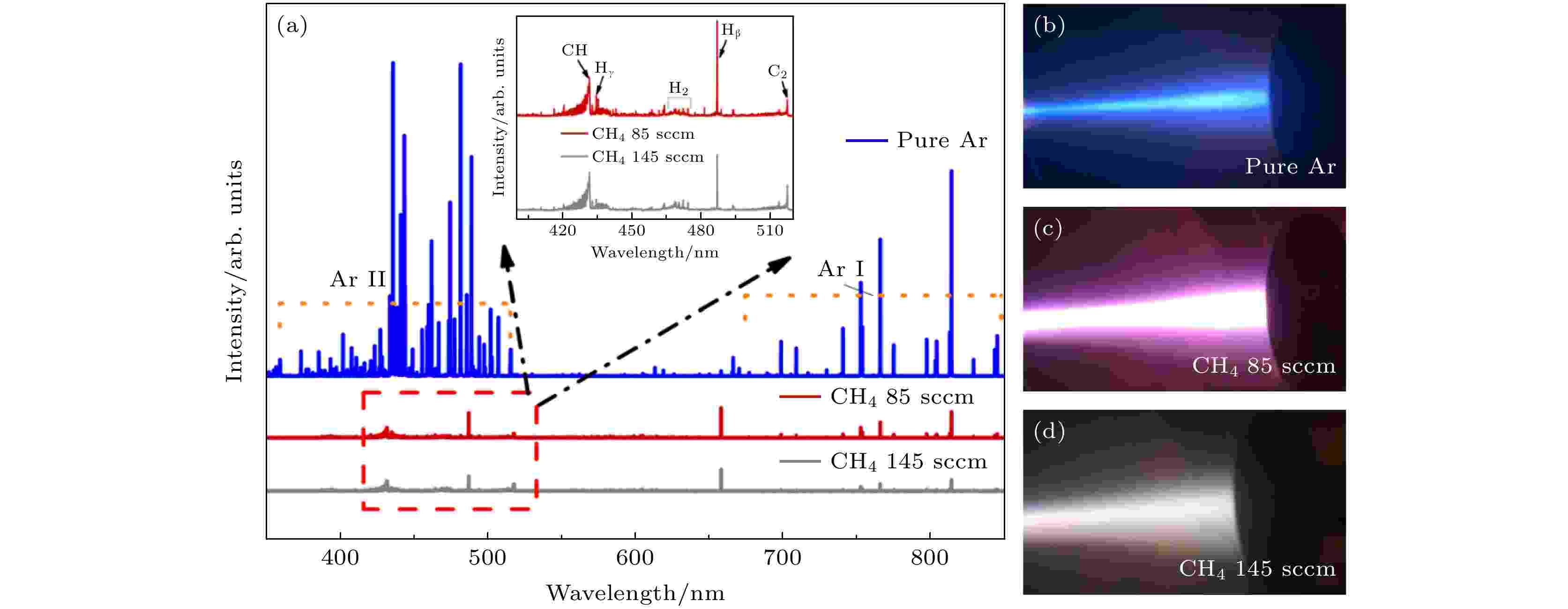 图 2 (a)纯氩、CH4流量为85和145 sccm时的发射谱线图; (b)?(d)对应纯氩气、CH4流量为85和145 sccm时的放电照片图
图 2 (a)纯氩、CH4流量为85和145 sccm时的发射谱线图; (b)?(d)对应纯氩气、CH4流量为85和145 sccm时的放电照片图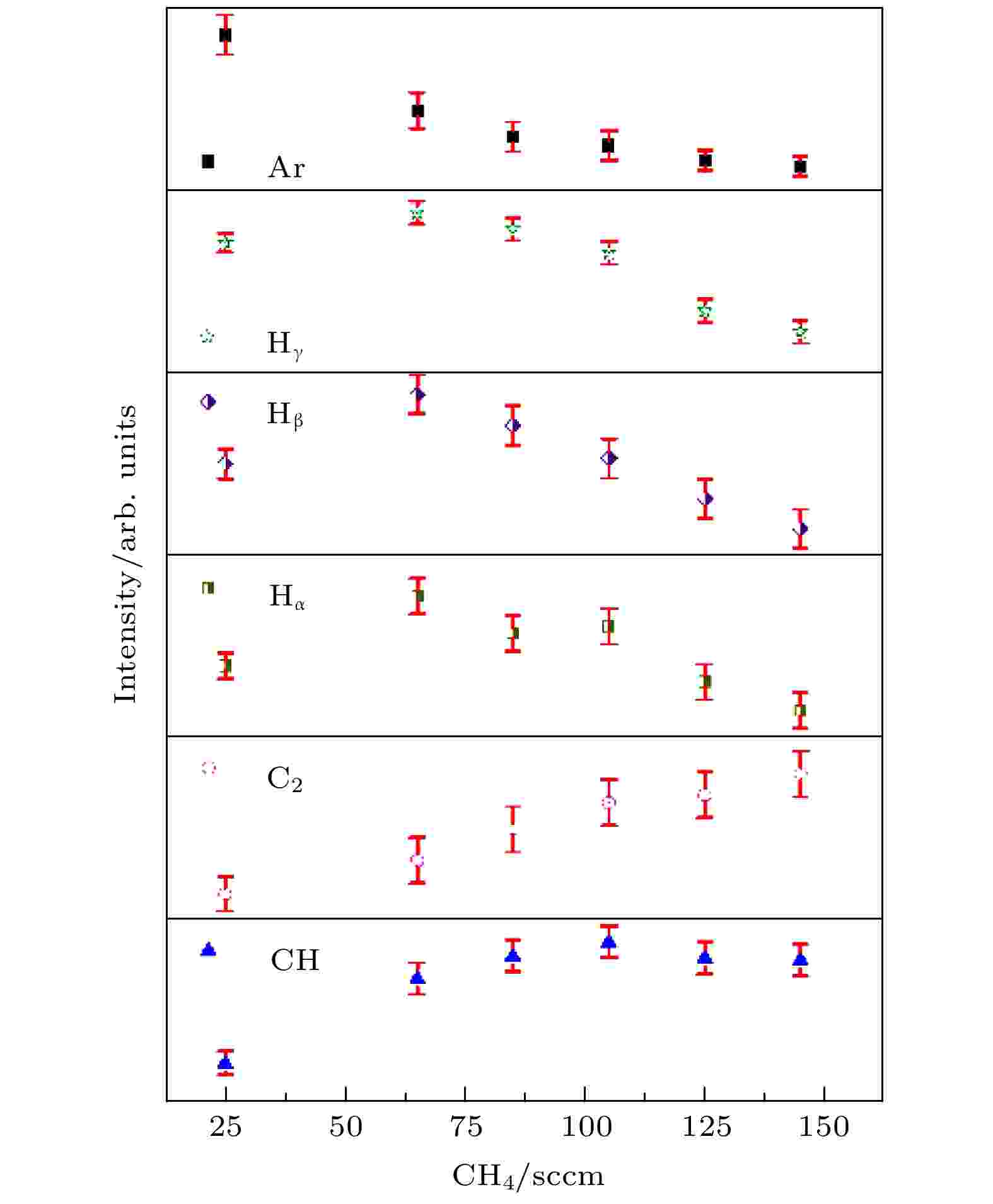 图 3 CH, C2, H Balmer和Ar*的发射强度与CH4流量的关系
图 3 CH, C2, H Balmer和Ar*的发射强度与CH4流量的关系






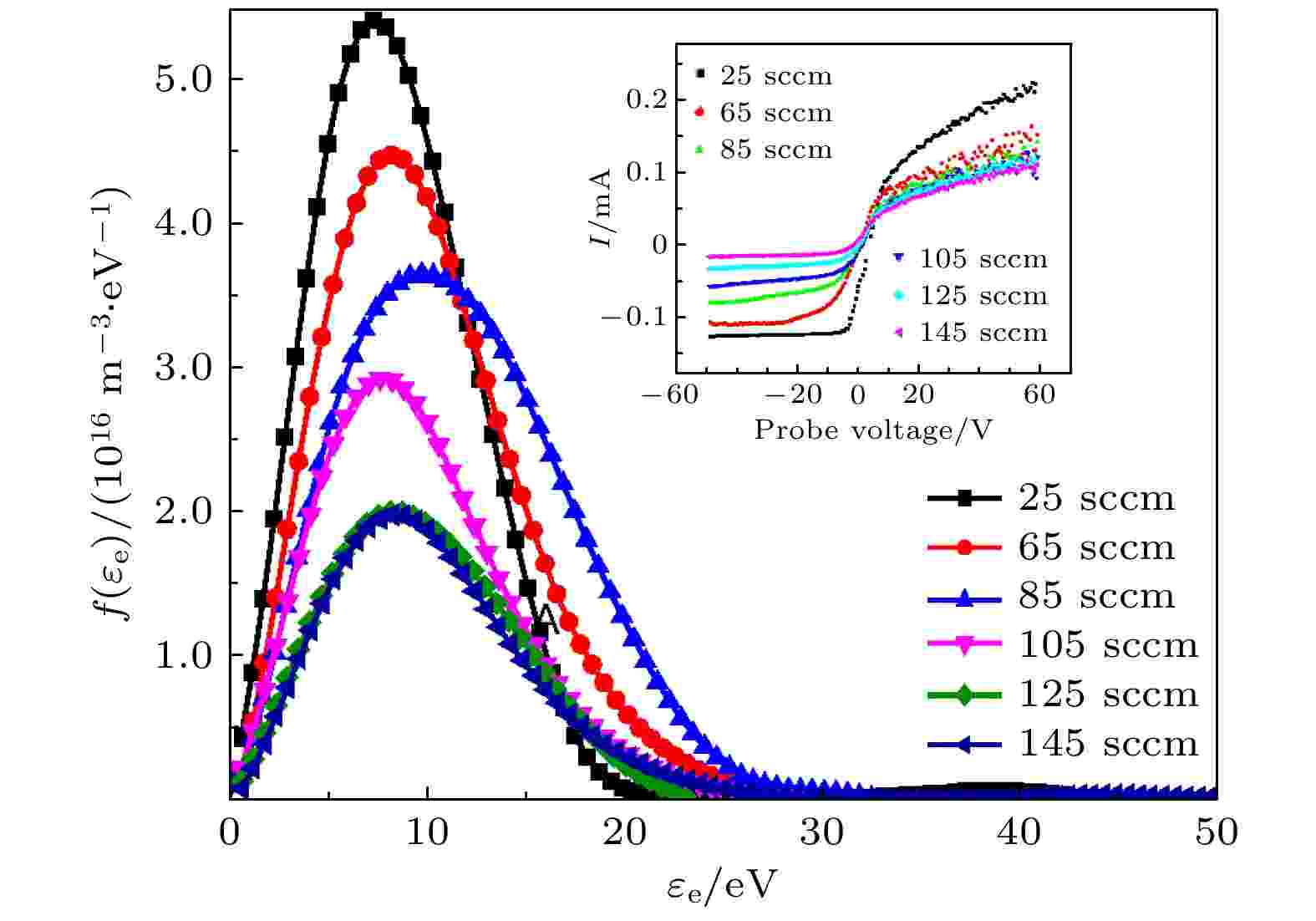 图 4 不同CH4流量下的电子能量分布函数
图 4 不同CH4流量下的电子能量分布函数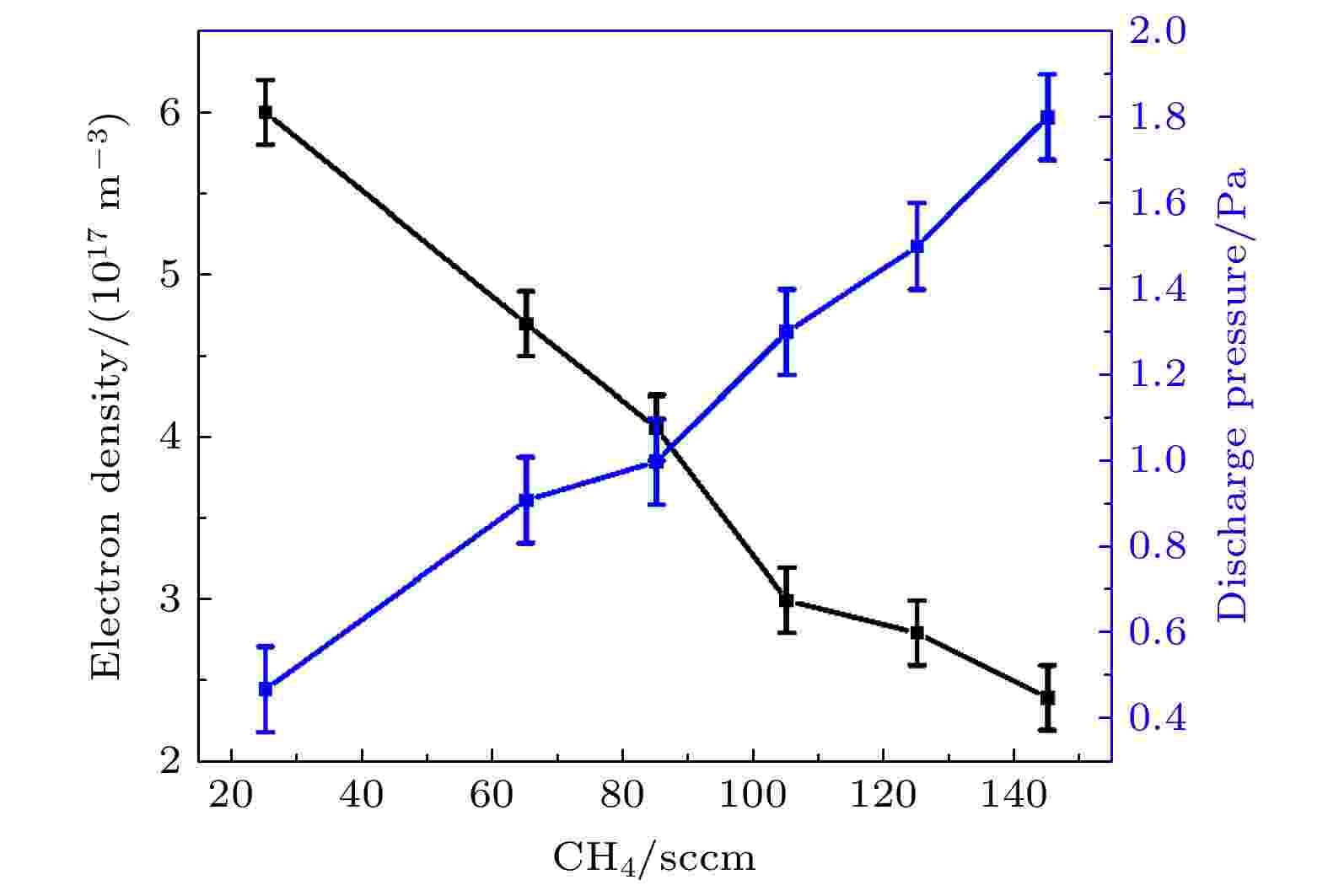 图 5 电子密度和放电气压随CH4流量增加的变化情况
图 5 电子密度和放电气压随CH4流量增加的变化情况















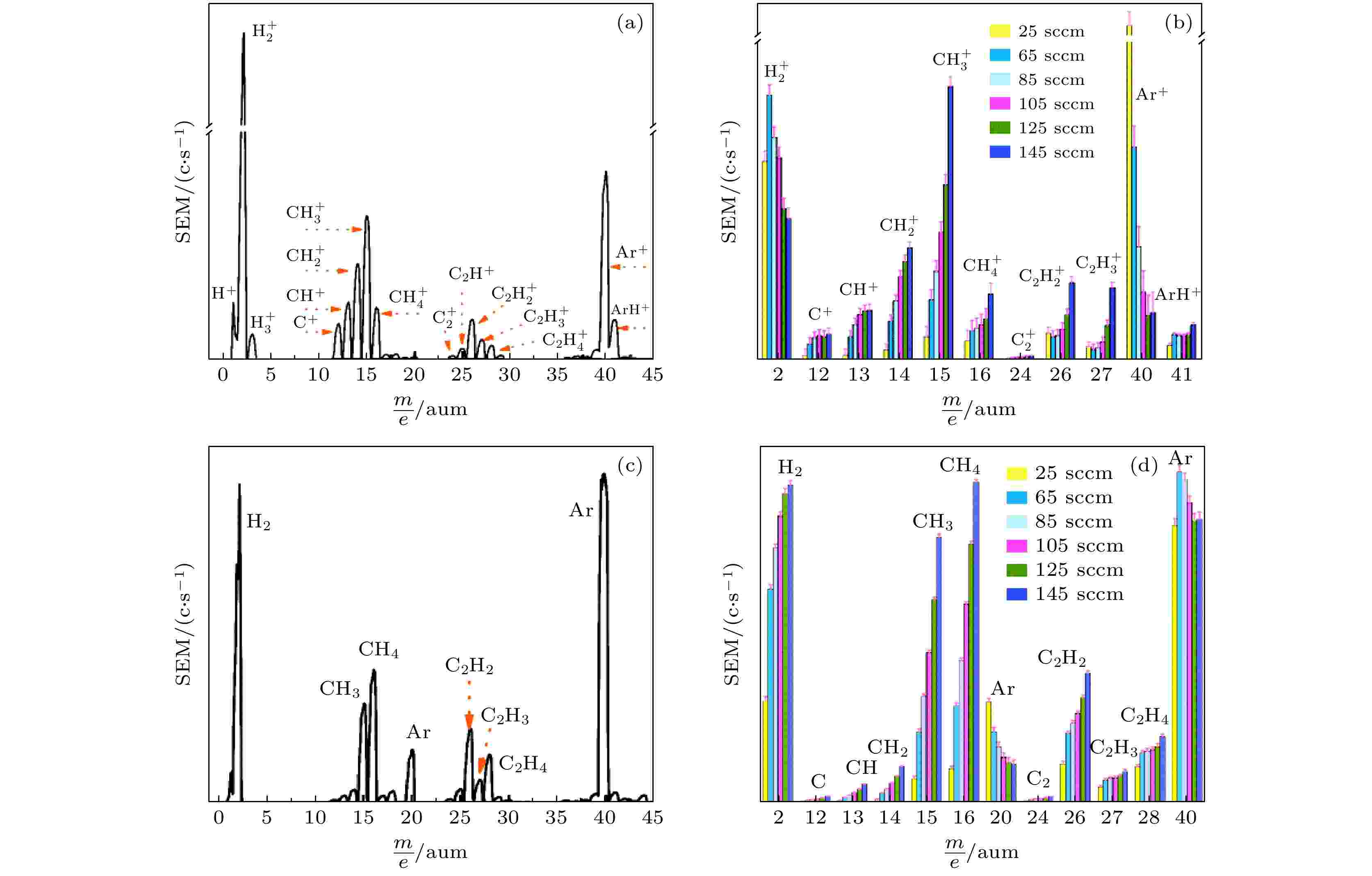 图 6 (a) +Ion谱图(CH4 85 sccm); (b)不同CH4流量下等离子体中+Ion含量变化; (c)中性粒子谱图(CH4 85 sccm); (d)不同CH4流量下等离子体中中性粒子含量变化. SEM, 二次电子倍增
图 6 (a) +Ion谱图(CH4 85 sccm); (b)不同CH4流量下等离子体中+Ion含量变化; (c)中性粒子谱图(CH4 85 sccm); (d)不同CH4流量下等离子体中中性粒子含量变化. SEM, 二次电子倍增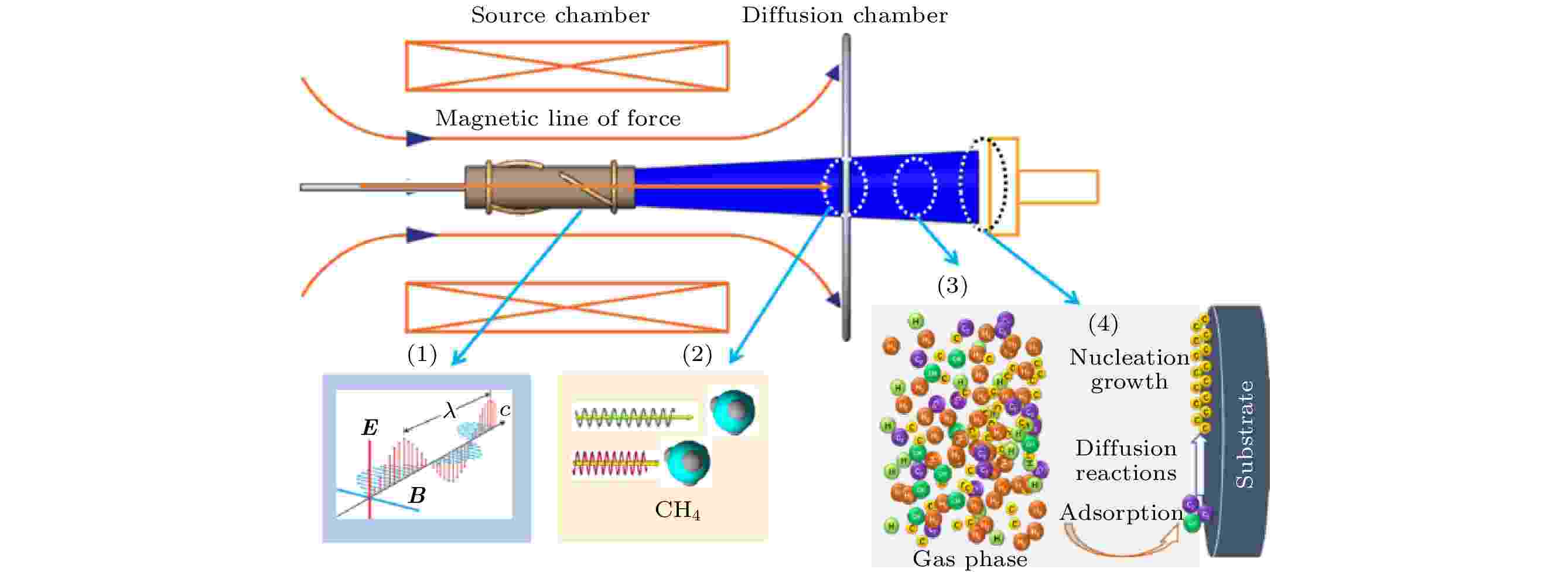 图 7 Ar/CH4螺旋波等离子体化学气相沉积制备碳基薄膜动力学过程
图 7 Ar/CH4螺旋波等离子体化学气相沉积制备碳基薄膜动力学过程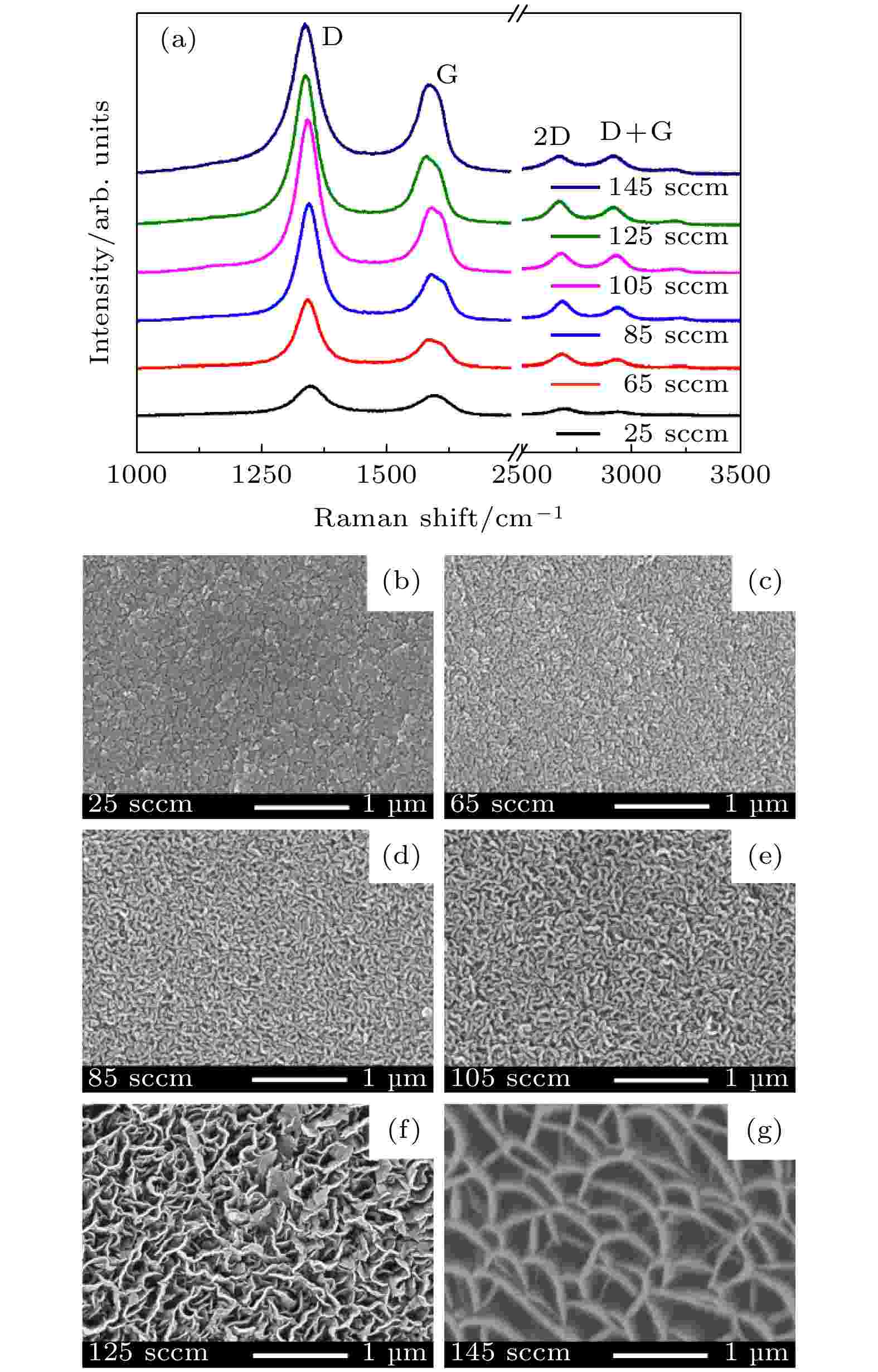 图 8 (a)不同CH4流量下碳基薄膜拉曼光谱图; (b)—(g)不同CH4流量情况下制备的碳基薄膜表面形貌图
图 8 (a)不同CH4流量下碳基薄膜拉曼光谱图; (b)—(g)不同CH4流量情况下制备的碳基薄膜表面形貌图